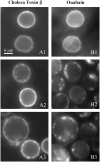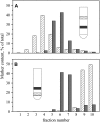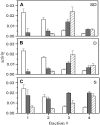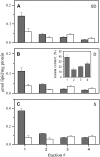Raft composition at physiological temperature and pH in the absence of detergents
- PMID: 17993486
- PMCID: PMC2267110
- DOI: 10.1529/biophysj.107.118596
Raft composition at physiological temperature and pH in the absence of detergents
Abstract
Biological rafts were identified and isolated at 37 degrees C and neutral pH. The strategy for isolating rafts utilized membrane tension to generate large domains. For lipid compositions that led only to microscropically unresolvable rafts in lipid bilayers, membrane tension led to the appearance of large, observable rafts. The large rafts converted back to small ones when tension was relieved. Thus, tension reversibly controls raft enlargement. For cells, application of membrane tension resulted in several types of large domains; one class of the domains was identified as rafts. Tension was generated in several ways, and all yielded raft fractions that had essentially the same composition, validating the principle of tension as a means to merge small rafts into large rafts. It was demonstrated that sphingomyelin-rich vesicles do not rise during centrifugation in sucrose gradients because they resist lysis, necessitating that, contrary to current experimental practice, membrane material be placed toward the top of a gradient for raft fractionation. Isolated raft fractions were enriched in a GPI-linked protein, alkaline phosphatase, and were poor in Na(+)-K(+) ATPase. Sphingomyelin and gangliosides were concentrated in rafts, the expected lipid raft composition. Cholesterol, however, was distributed equally between raft and nonraft fractions, contrary to the conventional view.
Figures








Similar articles
-
Lipid Raft Isolation by Sucrose Gradient Centrifugation and Visualization of Raft-Located Proteins by Fluorescence Microscopy: The Use of Combined Techniques to Assess Fas/CD95 Location in Rafts During Apoptosis Triggering.Methods Mol Biol. 2021;2187:147-186. doi: 10.1007/978-1-0716-0814-2_9. Methods Mol Biol. 2021. PMID: 32770506
-
Sphingomyelin and cholesterol: from membrane biophysics and rafts to potential medical applications.Subcell Biochem. 2004;37:167-215. doi: 10.1007/978-1-4757-5806-1_5. Subcell Biochem. 2004. PMID: 15376621 Review.
-
Transbilayer peptide sorting between raft and nonraft bilayers: comparisons of detergent extraction and confocal microscopy.Biophys J. 2005 Aug;89(2):1102-8. doi: 10.1529/biophysj.105.062380. Epub 2005 May 20. Biophys J. 2005. PMID: 15908585 Free PMC article.
-
Sterol carrier protein-2 selectively alters lipid composition and cholesterol dynamics of caveolae/lipid raft vs nonraft domains in L-cell fibroblast plasma membranes.Biochemistry. 2003 Dec 16;42(49):14583-98. doi: 10.1021/bi034966+. Biochemistry. 2003. PMID: 14661971
-
The state of lipid rafts: from model membranes to cells.Annu Rev Biophys Biomol Struct. 2003;32:257-83. doi: 10.1146/annurev.biophys.32.110601.142439. Epub 2003 Jan 16. Annu Rev Biophys Biomol Struct. 2003. PMID: 12543707 Review.
Cited by
-
Sorting of lens aquaporins and connexins into raft and nonraft bilayers: role of protein homo-oligomerization.Biophys J. 2009 Nov 4;97(9):2493-502. doi: 10.1016/j.bpj.2009.08.026. Biophys J. 2009. PMID: 19883592 Free PMC article.
-
Observations of Membrane Domain Reorganization in Mechanically Compressed Artificial Cells.Chembiochem. 2019 Oct 15;20(20):2666-2673. doi: 10.1002/cbic.201900167. Epub 2019 Oct 1. Chembiochem. 2019. PMID: 31087814 Free PMC article.
-
Coupling liquid phases in 3D condensates and 2D membranes: Successes, challenges, and tools.Biophys J. 2024 Jun 4;123(11):1329-1341. doi: 10.1016/j.bpj.2023.12.023. Epub 2023 Dec 29. Biophys J. 2024. PMID: 38160256 Free PMC article. Review.
-
Elastic Membrane Deformations Govern Interleaflet Coupling of Lipid-Ordered Domains.Phys Rev Lett. 2015 Aug 21;115(8):088101. doi: 10.1103/PhysRevLett.115.088101. Epub 2015 Aug 18. Phys Rev Lett. 2015. PMID: 26340212 Free PMC article.
-
GUV preparation and imaging: minimizing artifacts.Biochim Biophys Acta. 2010 Jul;1798(7):1324-32. doi: 10.1016/j.bbamem.2010.03.011. Epub 2010 Mar 17. Biochim Biophys Acta. 2010. PMID: 20302841 Free PMC article. Review.
References
Publication types
MeSH terms
Substances
Grants and funding
LinkOut - more resources
Full Text Sources
Other Literature Sources

